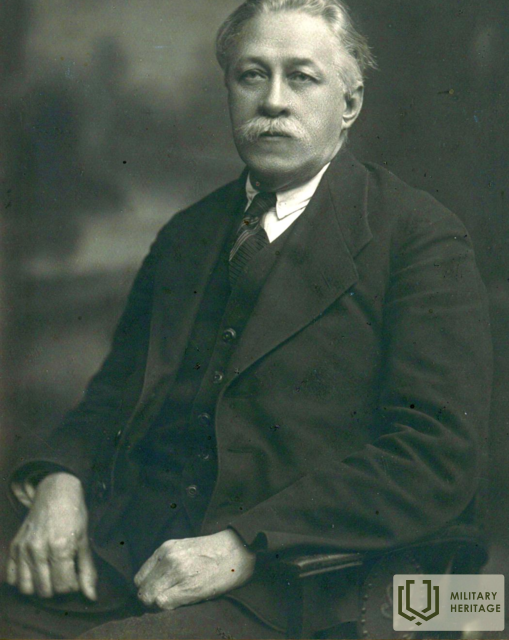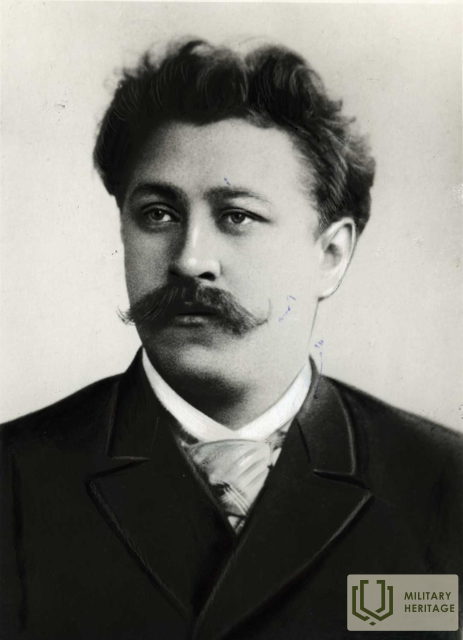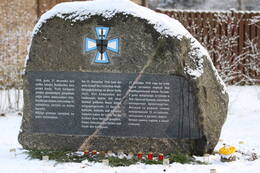Peter Stucky I World War I, I Wars of Independence
Pēteris Stučka (1865-1932) - lawyer, politician, publicist, bookseller, one of the leaders of the New Current, editor of several socialist and communist press publications.
Born in 1865 in “Vecbirznieki” of Koknese parish into a wealthy farming family. Stučka's father, Jānis Stučka, was a raftsman in his youth, later worked as a teacher and a priest, and after marrying, became the owner of a large farm.
In the autumn of 1879, he entered the Riga German Gymnasium, where he met Jānis Pliekšāns. In 1884, both began studying at St. Petersburg University, joining the university's Latvian student group. Stučka graduated from the university in 1888, returned to Riga and took on the duties of editor of the Latvian democratic newspaper "Dienas Lapa". In the summer of 1897, "Dienas Lapa" was temporarily closed, and Stučka himself was arrested. Until January 1898, Stučka was imprisoned in the Vidzeme provincial prison in Riga.
Then he was exiled to Vitebsk. After the suppression of the 1905 revolution, he returned to Riga. From 1907 he worked as a lawyer in St. Petersburg, founded a private publishing house “Dzirkstele”, began publishing a magazine popularizing Marxism in Latvian (the magazine changed its name several times – “Atvases”, “Jaunais Pūrs”, “Dzirkstele”, “Ciba” etc.), where he also published his reflections on a wide range of topics. He was also the head of the government of the Latvian Socialist Soviet Republic (1919), which was a result of the events that took place on December 4, 1918: the Latvian Soviet Government was established in Russia, which on December 17 distributed the Manifesto of the Latvian Soviet Government, in which it announced its basic goals. The head of the Latvian Soviet Government was Pēteris Stučka, who arrived in Valka from Pskov on December 21. The Red Army, including Latvian rifle regiments, was rapidly approaching Riga. On January 2, 1919, the Latvian Provisional Government led by Kārlis Ulmanis left it, leaving room for Pēteris Stučkas and his Soviet Latvian government.
P. Stučka's government decided that it would give the Russian comrades a model lesson in building socialism. He was overcome with the conviction that the "Latvian Labor Commune" had every chance of becoming a model for communists not only in Russia, but perhaps even on a European scale. The Latvian proletariat was destined to be the "torch in the revolutionary powder keg". This was the source of the terror and radicalism of reforms experienced in Soviet Latvia from January to May 1919, which could not be observed even in Russia. Stučka and his associates rushed to achieve the longed-for socialism as quickly as possible, but got burned because they quickly lost the hopes and support of the population, which led to the collapse and complete destruction of Soviet Latvia during the Latvian War of Independence. Pēteris Stučka played his role, but did it so politically poorly that he turned from a respected New Current member into a hated communist.
Later, P.Stuchka was the Chairman of the Supreme Court of the USSR (1923). In 1931, Stuchka was appointed director of the Moscow Institute of Soviet Law. The city of Aizkraukle, the Latvian State University and Tērbatas Street in Riga were named after Pēteris Stuchka. Pēteris Stuchka died on January 25, 1932 in Moscow and is buried in Red Square near the Kremlin wall.
More information sources
LU LFMI. Pēteris Stučka. Available: https://literatura.lv/lv/person/Peteris-Stucka/872473 [accessed 06.05.2021].
Latvian War Museum. Personalities and their achievements during the Latvian War of Independence. Available: http://www.karamuzejs.lv/lv/Petnieciba/publikacijas/12_Petnieciba_Neatkaribaskara_personibas_KP_201912.aspx [accessed 06.05.2021].
Related timeline
Related objects
Monument to the first battle for Latvia's independence
Located in Inčukalns, Atmodas Street 2.
On July 3, 2016, a monument to the first battle for Latvian independence was unveiled, dedicated to the Latvian Landeswehr (Die Lettländische Landeswehr), in which local Baltic Germans, Russians and Latvians, who were in units on both sides at the time, defended the newly founded state against the Bolshevik Red Army. Eižens Upmanis, the chairman of the Brothers' Graves Committee, concluded at the time that this could be the first monument to the combined Latvian and Baltic German forces in battle memorials outside the cemeteries. At that time, Lieutenant Colonel Oskars Kalpaks was appointed commander of the Latvian units of the Latvian Landeswehr, from whose units the later Latvian Army grew and formed during the Freedom Struggle.
In 1918, the entire territory of present-day Latvia had fallen into the hands of the German Empire and its troops. However, in the late summer and autumn of 1918, the situation began to rapidly turn against Germany and it was clear that it was only a matter of time before Germany would be forced to admit defeat in World War I. The Russian Empire, which Latvia was part of until World War I, had ceased to exist earlier, with the February and October revolutions of 1917. On 18 November 1918, the Republic of Latvia was proclaimed. The German army, which was located in the territory of Latvia, after the armistice with the Entente powers on 11 November 1918, was no longer motivated for further hostilities and most of its soldiers simply wanted to return to their homeland.
Under such circumstances, it was clear that the defense of Latvia depended primarily on a national guard formed by the Latvian population itself. Initially, due to their education and relatively greater ability to self-organize, the Baltic Germans living in Latvia showed the greatest initiative in forming such a national guard. Russian soldiers also joined the national guard. In order to ensure the supply of the national guard with uniforms, weapons and other necessary resources, the Latvian Provisional Government concluded an agreement with the German representative Augustus Vinnig on December 7, 1918, providing for the provision of the national guard from the German army reserves located in the territory of Latvia. This agreement indicated, among other things, that this national guard, with the official name “Latvijas zemessardze” or in German – “die Lettländische Landeswehr”, would be the armed forces of the Republic of Latvia.
The Latvian National Guard was confronted by two Latvian Red Riflemen regiments (i.e., approximately 2,000–3,000 soldiers) that had previously been experienced in World War I and the Russian Civil War. Despite the Red Army's experience and numerical superiority, the Latvian National Guard held Inčukalna in fierce battles for two days, until finally, on the evening of January 1, 1919, in order to avoid encirclement, it was forced to retreat, losing 43 killed and several wounded, most of whom were captured by the Bolsheviks, where they were killed or died of hunger or disease.
Author: Artis Buks. Material: Fieldstone. The monument is made of a large monolithic stone that was found in Ruļļi near Jelgava.








